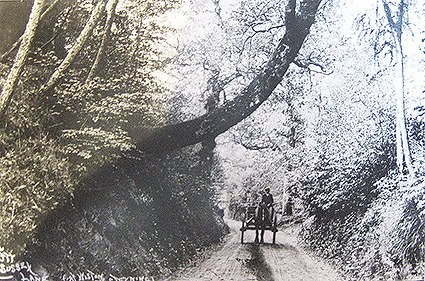
Steyning Museum Archives: Some Steyning Streets
If we want to find our way around Steyning we know, or could look up on our phones, where to find particular streets. If, however, we were thrown back in time we would have some difficulties. Where, for instance, were the rather ordinary sounding Middyllane or Lyttyllane? Middle Lane which ran from the vill (the centre of the town) to the Church is straightforward; it was Church Street. But there must have been several little lanes five hundred or more years ago and this specific Lyttyllane we cannot placeSome name changes are actually documented so we know that the field where Steyning men and boys practiced their archery, which we now call Shooting Field, used to be known as ‘The Howe’.
Others are lent a level of confusion either because of a relaxed approach to how they were spelt or because of difficulties in reading the medieval script. So Cobstrete, Coprestret and Cokstrete were quite likely to have all been the same lane but the variation in the spelling opened the door for speculation about its modern equivalent. Because all the names began with the letters ‘Co’, Coxham Lane became the favoured equivalent. But that would seem to be wrong.
In a court hearing in 1478 Cobstrete was reported to be 'in a very bad state and a day is given for it to be repaired'. The Court then became very specific as to who was responsible for its repair. On the one hand there was John Arnold, a burgess of Steyning, who at one time or another was the ale taster and the bailiff for the Borough. On the other was 'the Tithing of Charleton' with instructions being given for the street to be repaired 'in accordance with the custom of the Borough from which it runs (namely, Steyning) through the Tithing of Charleton, of which a day is given as much to the Tithing of Charleton for its part as to John Arnold for his part to repair it before the next View (the court of the ‘View of Frankpledge)'. So Cobstrete was a road needing repair and maintenance by both Steyning and Charlton – and there is really only one road which could, at that time, have been identified as a ‘street’ and which ran between the two. That was what we now call Mouse Lane – then the route into Steyning from the west. There is no sign on early maps or records of any road or lane anywhere near Coxham Lane.
It is also telling that William Pellett, who lived at Charlton Court, was arraigned by the court on nine different occasions for failing to undertake repairs to Cobstrete. Moreover, twenty five years later, the same road seems to have been in need of repair again when William Pellett left money in his will, in 1503, for 'the mending of the way between the forge and Charlton and Oxonbroke and between the forge and the great Barn 60 cartloads of stone'.
The exact interpretation of this is uncertain but ‘the forge’ may be that which lay not far from the present day Star Inn and ‘the great barn’ was probably the large barn at Charlton Court.
By 1597 the name Cobstrete had disappeared from Steyning’s topography and the lane had become known as Mowze Lane. If the name Cobstrete was descriptive of a road along which cobnut trees or hazels grew, then Mouse Lane could have acquired its name descriptively as well. John Goring told Janet Pennington that you only had to look up the lane with its overarching trees to think of a large mousehole or rathole, though others have pointed out that waggons loaded with grain on their way to Court Mill probably shed enough of their loads to allow rats and mice to thrive.
However that might be, those who make regular use of this lane will not be in the least surprised to discover that the water racing down the lane after heavy rain lead to the need for its frequent repair in past centuries.
Article by: Chris Tod - Steyning Museum.

